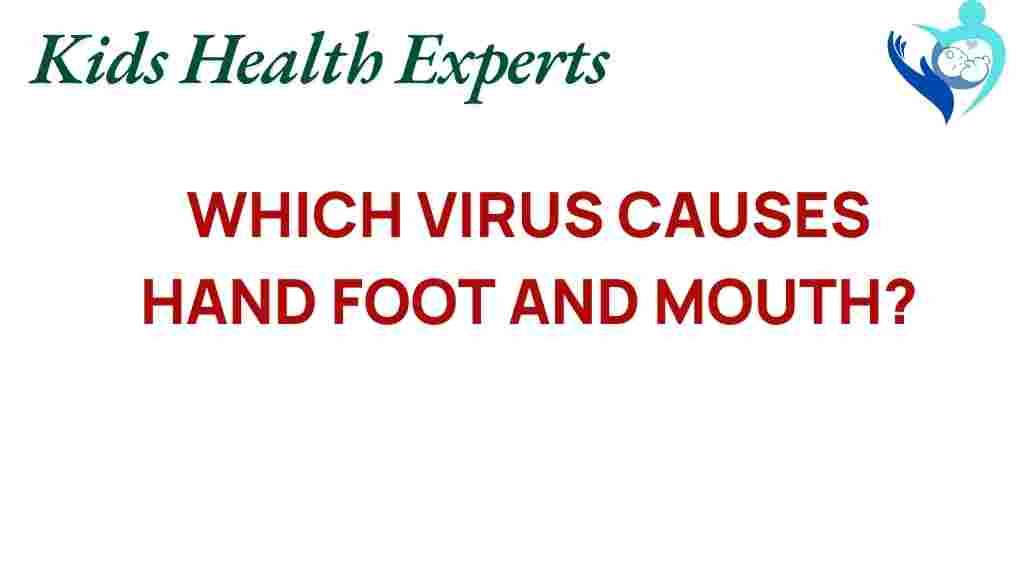Unraveling the Mystery: Which Virus Causes Hand, Foot, and Mouth Disease?
Hand, foot, and mouth disease (HFMD) is a common viral infection that primarily affects young children. It is characterized by fever, mouth sores, and a rash on the hands and feet. Understanding the viruses that cause HFMD is crucial for parents and caregivers, especially during outbreaks. This article will delve into the specifics of hand, foot, and mouth disease, focusing on the primary viruses responsible, namely Coxsackievirus and Enterovirus, as well as symptoms, prevention, treatment, and management strategies.
What Causes Hand, Foot, and Mouth Disease?
Hand, foot, and mouth disease is primarily caused by two groups of viruses: **Coxsackievirus** and **Enterovirus**. The most common strain responsible for HFMD is the Coxsackievirus A16, but other strains of the Enterovirus family can also cause similar symptoms. Here’s a breakdown of these viruses:
- Coxsackievirus: This virus is part of the Enterovirus genus and is often associated with HFMD. In addition to causing HFMD, it can lead to other illnesses, including myocarditis and aseptic meningitis.
- Enterovirus: Enteroviruses are a large group of viruses that can also lead to HFMD. Enterovirus 71 (EV71) is another strain that has been linked to more severe outbreaks of the disease.
Symptoms of Hand, Foot, and Mouth Disease
The symptoms of hand, foot, and mouth disease typically appear within three to seven days after exposure to the virus. The initial signs may include:
- Fever: A mild fever often precedes other symptoms, usually ranging from 100°F to 102°F (37.8°C to 38.9°C).
- Sore Throat: Children may complain of a sore throat or difficulty swallowing due to painful mouth sores.
- Mouth Sores: Painful red spots or sores can develop inside the mouth, particularly on the tongue and inside of the cheeks.
- Rash: A rash usually appears on the hands and feet. It can manifest as small red spots, sometimes with blisters.
- Loss of Appetite: Due to mouth sores, children may refuse to eat or drink.
While HFMD is generally mild, it can occasionally lead to complications, especially in children with weakened immune systems.
How Does Hand, Foot, and Mouth Disease Spread?
Hand, foot, and mouth disease is highly contagious, particularly among children. It spreads through:
- Direct Contact: The virus can spread through direct contact with an infected person’s bodily fluids, such as saliva, nasal mucus, or fluid from the blisters.
- Surface Contamination: The virus can survive on surfaces, toys, or objects that an infected person has touched.
- Aerosol Transmission: Coughing and sneezing can also release droplets containing the virus into the air.
Outbreaks often occur in childcare settings, schools, and playgrounds, particularly during late summer and early fall.
Prevention of Hand, Foot, and Mouth Disease
Preventing hand, foot, and mouth disease is essential, especially during outbreaks. Here are some effective prevention strategies:
- Hand Hygiene: Regular handwashing with soap and water, especially after using the restroom, changing diapers, and before meals, is crucial.
- Avoid Close Contact: Keep children away from infected individuals and discourage sharing utensils, towels, or personal items.
- Disinfect Surfaces: Regularly clean and disinfect toys, surfaces, and common areas in childcare settings.
- Stay Home: If a child is infected, keep them home from school or daycare to prevent spreading the virus to others.
Treatment for Hand, Foot, and Mouth Disease
Currently, there is no specific antiviral treatment for hand, foot, and mouth disease. Management focuses on relieving symptoms and ensuring comfort for the affected child. Here are some common treatment approaches:
- Pain Relief: Over-the-counter pain relievers like acetaminophen or ibuprofen can help alleviate fever and discomfort.
- Hydration: Encourage the child to drink plenty of fluids to prevent dehydration, especially if they have sores in their mouth that make swallowing painful.
- Soft Foods: Offer soft, bland foods that are easy to swallow, such as yogurt, applesauce, or mashed potatoes.
- Topical Treatments: Some parents find that topical anesthetics can help numb mouth sores, providing temporary relief.
It is essential to consult a healthcare provider if symptoms worsen or if there are concerns about dehydration or complications.
Managing Outbreaks of Hand, Foot, and Mouth Disease
In the event of an outbreak of hand, foot, and mouth disease, it’s crucial to have a response plan. Here are steps to consider:
- Inform Parents: Keep parents informed about the outbreak and the importance of monitoring their children for symptoms.
- Increase Cleaning Protocols: Enhance cleaning and disinfection procedures in schools and daycare facilities to minimize virus transmission.
- Encourage Sick Children to Stay Home: Reinforce the need for ill children to stay home until they are symptom-free for at least 24 hours.
- Monitor Attendance: Keep track of attendance to identify patterns of illness and take appropriate action if necessary.
Conclusion
Hand, foot, and mouth disease is a common yet manageable viral infection primarily caused by **Coxsackievirus** and **Enterovirus**. Understanding the symptoms, transmission, prevention, and treatment options is vital for parents and caregivers, especially during outbreaks. By practicing good hygiene and staying informed, we can help minimize the impact of HFMD on our children and communities.
For more detailed information on viruses and their impact on children’s health, you can visit CDC’s website. Additionally, if you’re looking for more resources on child health, check out our articles here.
This article is in the category Conditions and created by KidsHealthExperts Team
